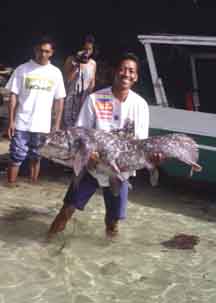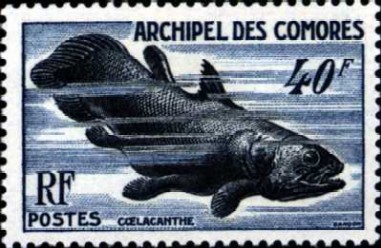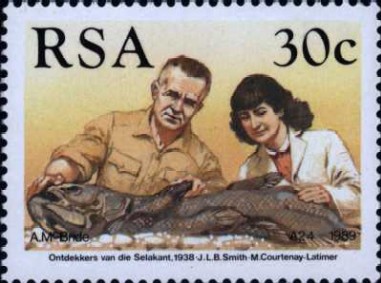Coelacanth: Rock Star
Posted by: Loren Coleman on February 26th, 2007

Some might say the elusive coelacanth, in spite of its primordial ugliness, has attained rock star status in the popular imagination. Chris Justice, Assistant Professor of English and Mass Communication at The Community College of Baltimore County, February 26, 2007

Of course, you and I didn’t need the good professor to tell us the coelacanth is an amazing animal, a great story, and, yes, a rock star. But it is always wonderful to know that so many people agree with us that this is one very remarkable species.
Jokes and introductions aside, one of the more fascinating finned creatures to enter the collective consciousness of popular culture in recent years has been the prehistoric coelacanth (that’s “see-la-kanth”). With ancestral and genetic links to fish and amphibians from the Devonian Period (400-360 million years ago), this fish is a cryptozoologist’s dream come true. And apparently, scientists are not its only fans.Chris Justice

Justice has written a good overview of the coelacanth, with a great roundup of photographs he’s reeled in from various sources, in his blog today, “The Tackle Box: Defying Extinction and Celebrating the Strange”. If you can’t get enough of the coelacanth, check it out.
About Loren Coleman
Loren Coleman is one of the world’s leading cryptozoologists, some say “the” leading living cryptozoologist. Certainly, he is acknowledged as the current living American researcher and writer who has most popularized cryptozoology in the late 20th and early 21st centuries.
Starting his fieldwork and investigations in 1960, after traveling and trekking extensively in pursuit of cryptozoological mysteries, Coleman began writing to share his experiences in 1969. An honorary member of Ivan T. Sanderson’s Society for the Investigation of the Unexplained in the 1970s, Coleman has been bestowed with similar honorary memberships of the North Idaho College Cryptozoology Club in 1983, and in subsequent years, that of the British Columbia Scientific Cryptozoology Club, CryptoSafari International, and other international organizations. He was also a Life Member and Benefactor of the International Society of Cryptozoology (now-defunct).
Loren Coleman’s daily blog, as a member of the Cryptomundo Team, served as an ongoing avenue of communication for the ever-growing body of cryptozoo news from 2005 through 2013. He returned as an infrequent contributor beginning Halloween week of 2015.
Coleman is the founder in 2003, and current director of the International Cryptozoology Museum in Portland, Maine.










The coelacanth is often said to be an ugly fish. In reality, they are beautiful animals when they are still alive, and completely unlike the colourless and yellowed specimens (when they are dead and) saved in formaldehyde.
I agree, Sordes. I always find it amusing how people will hold creatures up to our own aesthetic priciples. The coelacanth probably think WE are the ugly ones.:)Beauty is all in the eye of the beholder is it not? I think these are gorgeous animals, but then again I think the giant squid is a beaut too. I can’t understand how anyone could look at these animals, unchanged for millions of years, surviving in harmony with theri environment and see an ugly creature.
It would seem that the “uglier” a creature is to us, the better adapted to survival it is. Dogs may be “cute” to us, but how well would one survive in the wild by itself? And how “ugly” are feral dogs that do live in the wild?
I think all fish are beautiful! 🙂 But I’m biased 😀
Chris.
The original discovery creature, floating in a glass tank of amber preserving fluid is on display in what for a long time was an out of the way corner of San Francisco’s California Academy of Science in Golden Gate Park. I was always drawn to it with a sense of considerable awe.
When I worked in the Atlantic City Aquarium, I would always respond to people who commented on the ugliness of our green moray eel by saying that he probably didn’t think much of them either. Horseshoe crabs also got a lot of ick comments, but I would usually opt for pointing out its streamlined shell and its other perfect adaptations to its environment. I think they’re quite beautiful, almost like samurai armour in their complexity and elegance. All animals have something beautiful about them, even ugly ol’ us.
Mnynames,
You’re right about the inherit beauty of all animals (although I recognize the “ick” factor too lol).
No matter how “icky” it is, an animal in its natural environment is a beautiful creature.
It’s ancient wisdom but worth repeating when it comes to the natural world (regardless of our personal sense of aesthetics) now that the assault against it has reached heighths possible only with our technological ability to destroy: We protect what we love, we love what we know, and we know what we’re taught. Finding out more about the natural world is the best way to protect it so others can appreciate it for a long long time. Thanks for opportunities like this.
There are only very few animals which I would declare as ugly. Some deep-sea fishes look really strange and many people surely feel disgusted about them, but for me this perfect astonishing creatures have also their beauty. But some of our pet animals are nothing more than ugly monstrosities. Dogs with deformed and too short jaws, and too much skin as well as several breeds of cats. Some of the most monstrous creatures were breeded from the beautyful goldfish, but this double-tailed, fat and malformed creatures with oversized swollen eyes and tumor-like outgrowths in their head are for my sense of taste. This creatures are only born because some people love this malformed freaks. Animals like mice if implanted ears are something different, they are for science and we have a lot of purpose from them.
“We protect what we love, we love what we know, and we know what we’re taught.”
I couldn’t have said it better myself, Dogu4. Teaching people about the importance of animals they may not care about, may even have carelessly abused as children (Woe be to the poor Horseshoe Crab), has been my job for the past 8 years. My boss always thought I was a little crazy for trying twice as hard to engage my audience if they expressed disinterest. My job was to get them to see how important and fragile all the environment is, and how we think effects what we do to it. I’m proud to say that I was usually successful.
Mnynames; that ancient wisdom is the foundation on which almost all meaningful learning s based, and is particularly apropos in exposing the uninitiated to the interpretation of natural history. Have you tried convincing an audience to love mosquitoes?
Not that I’m aware of, but I may have done. I was constantly being asked what the “purpose” of an animal was, which I always thought was a little crass, as if it were a tool or something. But, all animals have a purpose in the ecosystem, so it’s certainly an answerable question, even if often the person really wanted to know what purpose it served to us, as if being alive and part of the ecosphere wasn’t enough.
I’m sure I’ve discussed insects in general, and how enormously important they are as a food source, particularly of birds. Conversely, the birds are important as a natural control of said bugs. One of my favourite topics to regale people with was ticks, of which we have no shortage here in NJ. Most people assume that’s the way it always was, but the truth of the matter is that the proliferation of ticks is partially due to humans no longer clearing brush, or allowing brush fires to run their course. During the time of the Revolutionary War, a man could run through the woods from Cape May (Southern tip of NJ) to Monmouth (Upper middle of the state) without ever becoming entangled in thickets. Now, barring the use of roads, it’d be a tough slog to go from one town to the next using just the woods.
Even when I was a teen though, the tick population wasn’t too bad. If you were out in the woods all day, you might find one or two on you. Now, even a short trip might garner you dozens. The reason for that is an unfortunate confluence of events back in 1996. Every 17 years, the tick population nearly doubles as part of a natural cycle, and 1996 was one of those years. But before the ticks became available as a food source, NJ suffered a very bad ice storm and unusually harsh winter conditions, which killed off a significant number of songbirds. So, predators were halved at precisely the time the prey was doubled. Ticks have been numerous ever since.
Well, Mnynames, you are right about people asking about the purpose of the creature. Some might be suprised how ill informed the general public is on different creatures’ roles in the ecosystem so I give you kudos for trying to educate them on these matters. I have had similar experiences with trying to get a class of high school students to think, say, a Japanese giant salamander was cute or useful. It can be frustrating to run into close mindedness in the general public, but I love just having a chance to teach someone about these things. If I can make even one student realize the majesty and awe of the natural world, then I feel I have done something worthwhile. I gether you felt kind of the same way working at the aquarium.
“If I can make even one student realize the majesty and awe of the natural world, then I feel I have done something worthwhile. I gather you felt kind of the same way working at the aquarium.”
Precisely. This is the only effective way that naturalists can reproduce themselves (LOL)…and much easier than having children of their own (Although I’d like to think I have my own Bindi Sue Irwin with my own daughter, but time will tell).
I’m not sure how I fell into my interests as a child, as I don’t really recall any mentors, or much encouragement for that matter, but I always made time for those kids who were interested in learning more (Actually, I’ve been known to do that in other aquariums and museums too. I once stole half a tour group from its guide in the Smithsonian’s Natural History Museum, because I could answer their questions. I believe I was 7 at the time. I’m STILL quite proud of that accomplishment). I can tell you too, that it’s quite an ego boost when you hear, “Man, this place sucks” when a school group walks in, and, “Man, that was SO cool!” when they walk out, particularly if it’s the same kids who say it. I think teachers fail to teach when they fail to make their topics interesting, or to engage their students in dialogue, or when they talk down to their students.
And never forget that a simple story or anecdote can convey more information, and be far more memorable, than any dry recitation of facts, no matter how extraordinary those facts might be. It’s one thing to say that the Horseshoe Crab population is declining due to overharvesting, and that 50% of them (About 11.5 million crabs) have disappeared within the last 10 years. It is quite another to relate how when I was a kid, I could find hundreds crawling about at the water’s edge on the oceanside, and literally thousands on the bayside of Brigantine Island, while now, at the peak of their mating season, I usually see no more than 12 total at any given point. That’s something that people can relate to, and remember.
Mnynames, you are right on so many levels and I can relate to you one hundred percent. My own daughter is still only 6 months old, so time will tell with her! 🙂 But as far as my students go, I am very pleased when they come out of a class or field trip to the zoo or aquarium and they go from thinking it was boring in the begginning to thinking it was cool at the end. I was quite the same as you as a kid, answering questions at the zoo and whatnot! My father was supportive, but I was certainly odd for my age, reading books on the subject meant for much older people, always out traipsing about looking for bugs or lizards to study, sitting for hours in front of zoo exhibits just pondering the animals while my parents begged me to let them go home. I don’t think anybody else but me saw what was so fascinating about what I was seeing. Then in high school, I had a science teacher that really just made everything so interesting for everyone and I saw the effect he had on all of the students who would have laughed or said “this sucks” before. It was then when I thought that that was what I wanted to do, to impart my knowledge and enthusiasm for the subject onto other people. And I’ve never looked back. I am totally with you on making things accessible for students as well as fun. I’ve never been one to put the students to sleep, I would hope! When I can give a class on, say, the concept of a parasite’s life cycle and have them laughing and learning rather than sleeping or saying “ewww”, then I feel as happy as I can be. If a student tells his friends how cool my class is, then I feel I have opened a new world to them. I always make it relate to them because you are absolutely right when you say that this is the key to not only making people learn, but making people WANT to learn. I also think it is important to treat them with respect and to give them a chance to say their opinions without being talked down to or laughed at. This is what teaching is all about to me.